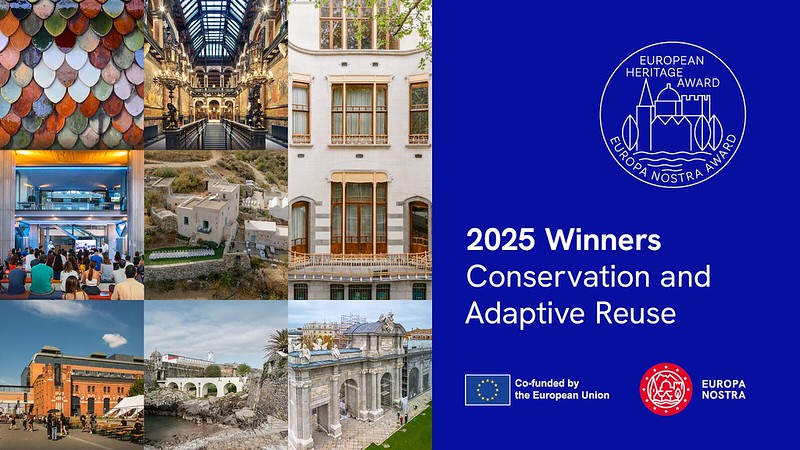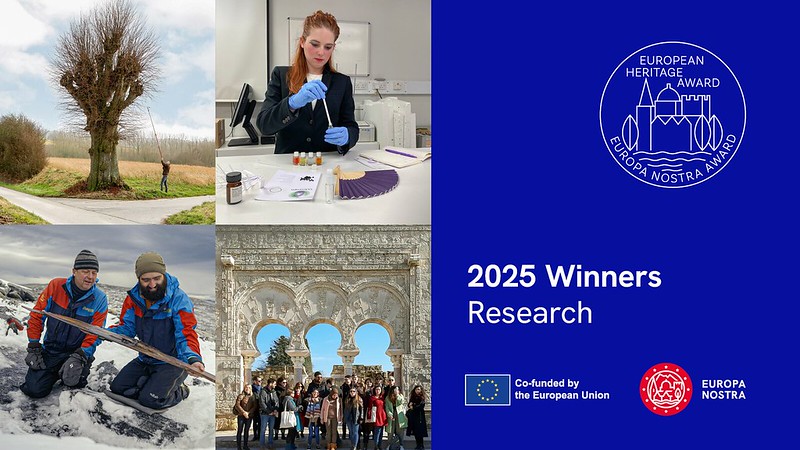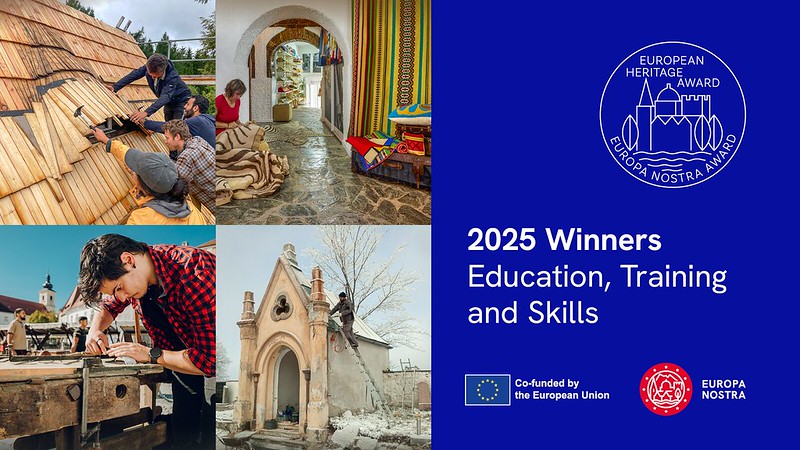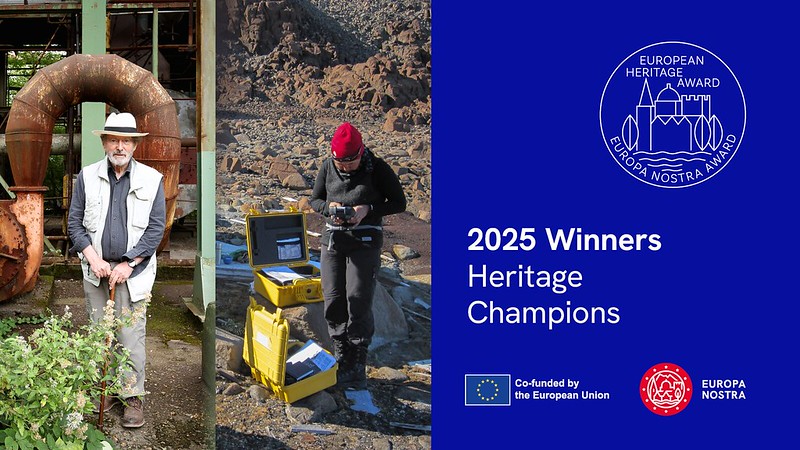2025 marks the 23rd anniversary of the European Heritage Awards / Europa Nostra Awards.
The Awards were launched in 2002 by the European Commission and have been implemented by Europa Nostra ever since. Co-funded by Creative Europe, the Awards aim at promoting best practices and transnational collaborations on cultural heritage interventions, research and awareness-raising.
30 outstanding achievements of tangible and intangible heritage are honoured every year, to empower heritage excellence by example. Among the 30 winners, up to five initiatives are awarded as Grand Prix by an independent jury and one initiative is voted by the audience as the Public’s Choice Winner.
Α total of 251 eligible applications by organisations and individuals from 41 European countries were submitted to this year's competition.
According to the Organizers "The 2025 winners exemplify the creativity and innovation demonstrated across Europe in efforts to safeguard and promote the unity in diversity of our rich heritage".
Heritage enthusiasts are now called to discover the 30 winners and vote online for the winner of the Public Choice Award 2025. Votes are open until 12 September.
Glenn Micallef, European Commissioner for Intergenerational Fairness, Youth, Culture and Sport, congratulated all winners and stated that: “Europe stands as a global cultural powerhouse. It is our duty and responsibility to ensure future generations can experience the richness and diversity of our heritage. The European Heritage Awards / Europa Nostra Awards not only reflect how cultural heritage is deeply valued in Europe, but they also celebrate and honour this legacy and the ongoing efforts of cultural professionals and volunteers working across the continent to safeguard and promote it. By advancing inclusivity, fostering solidarity, promoting international cooperation, and encouraging intergenerational dialogue, they embody the very essence of our European values”.
Cecilia Bartoli, the world-renowned mezzo-soprano and President of Europa Nostra, congratulated the winners and said that: “Cultural heritage connects people across generations and borders. It brings Europe’s citizens closer together, united in our rich diversity. It brings beauty and meaning to our daily lives, and shows how it can help shape a more sustainable and inclusive future”
Next stop is the European Heritage Awards Ceremony 2025 on 13 October, in the presence of European Commissioner Glenn Micallef and Europa Nostra’s Executive President Hermann Parzinger. It will be the highlight of the European Cultural Heritage Summit 2025, 12 - 14 October in Brussels.
In the ceremony, all the 30 winners will be celebrated. The Public's winner and the independed jury's Grand Prix Laureates will be announced and entitled to receive a monetary award of €10,000 each.
Winners of the European Heritage Awards / Europa Nostra Awards 2025
Discover below the winners of the European Heritage Awards / Europa Nostra Awards 2025, presented under the competition's five categories and by alphabetical order of countries, according to the official press release of the Awards.
Category Conservation & Adaptive Reuse

Tower Roof of the Church of St. Mauritius, Spitz an der Donau, AUSTRIA
The restoration of the polychrome-tiled medieval roof of St. Mauritius’ Church in Spitz an der Donau secured Austria’s only surviving late medieval roof of its kind. Combining traditional craftsmanship with advanced research and careful conservation methodologies, the project has further reconnected the community with its heritage.
Antwerp City Hall, BELGIUM
The restoration of Antwerp City Hall reinforced its function as the political and administrative heart of the city. Through a holistic and technically sophisticated approach, this project enhanced public access and sustainability while safeguarding a UNESCO-listed Renaissance landmark for future generations.
Hôtel Solvay, Brussels, BELGIUM
The restoration of Hôtel Solvay in Brussels, an Art Nouveau landmark by Victor Horta, addressed serious structural and waterproofing issues. Combining traditional craftsmanship with technical innovation, this project offers a compelling model for heritage conservation and sustainable maintenance in Europe.
Nicosia Old Municipal Market, CYPRUS
This project revitalised the Nicosia Old Municipal Market, transforming a modernist 1960s landmark near the Buffer Zone into a centre for innovation and civic exchange. Earthquake-resistant and inclusively designed, the new AGORA hub supports urban regeneration and bicommunal cooperation in Cyprus.
Kambones 1615 Historic House, Naxos, GREECE
Kambones 1615, a privately restored Venetian tower house on the island of Naxos, preserves five centuries of architectural, agricultural and cultural heritage. Using traditional techniques, this project blends sustainability, craft and community to create a model for heritage-led rural regeneration in Europe.
EC1 Łódź - City of Culture Complex, POLAND
EC1 in Łódź was transformed from a historic power plant into a vibrant cultural and educational complex. With museums, science centres, cinemas and inclusive public space, EC1 offers a powerful model for revitalising industrial heritage across Europe.
National Museum of Resistance and Freedom - Peniche Fortress, PORTUGAL
The Peniche Fortress, one of the main political prisons during the dictatorship in Portugal, now hosts the National Museum of Resistance and Freedom. Through careful adaptation and civic engagement, the site fully engages visitors with the values of liberty and democracy.
Puerta de Alcalá, Madrid, SPAIN
The restoration of the Puerta de Alcalá – a symbol of Madrid and part of a UNESCO World Heritage Site – combined traditional craftsmanship and scientific analysis in a large-scale public project, setting new standards for transparency, research, and public engagement.
Category Research

The Heritage Trees Project, BELGIUM
This research project safeguards the genetic and cultural heritage of monumental trees in Flanders by growing their descendants. Through community involvement, education, and the practical implementation of conservation methods, it creates a transferable model linking heritage preservation, biodiversity, and climate action.
Odeuropa, NETHERLANDS / FRANCE / GERMANY / ITALY / SLOVENIA / UNITED KINGDOM
Odeuropa explored the significance of smell in European heritage from the period 1600-1920. Using AI, historical sources and collaborative tools, this research project developed new methods, vocabularies and training resources, placing scent-based heritage firmly on the cultural map.
Glacier Archaeology Programme - Secrets of the Ice, NORWAY
Secrets of the Ice is a groundbreaking research programme in Norway’s Innlandet County, documenting over 4,500 artefacts – half of the world’s glacial archaeological findings. By uniting scientific innovation, methodology, education and public engagement, it highlights the urgent impact of climate change in high-altitude archaeology.
IS-LE: Islamic Legacy, pan-European project coordinated in SPAIN
This research project, with over 80 institutional partners from 40 countries, reframed the study of Islamic heritage in Europe and the Mediterranean. Through collaborative research, training, and open resources, it connected fragmented research traditions and fostered new narratives for academics, policymakers and society at large.
Category Education, Training & Skills

European Heritage Volunteers Programme, GERMANY
These training courses are organised at heritage sites across Europe, involving participants from countries worldwide. The training programme is cost-effective and grass-roots in nature, bridging generations and cultures, revitalising neglected sites, and demonstrating the value of hands-on, community-based heritage practice.
“Saber Fazer” Programme, PORTUGAL
“Saber Fazer” is Portugal’s national strategy for the safeguarding of traditional crafts and skills. It promotes knowledge transfer, sustainability and territorial cohesion by bridging urban-rural divides – turning ancestral techniques into tools for cultural and economic resilience.
ASTRA Center for Activities and Regional Resources, Sibiu, ROMANIA
The ASTRA Center in Sibiu revitalised a medieval guildhall as a vibrant training, certification and cultural hub. Through innovative partnerships, it set a national precedent for recognising traditional crafts, professionalising artisans, and linking heritage, education, and community resilience.
Pro Monumenta - Preventive Maintenance of Monuments, SLOVAKIA
Pro Monumenta is a national initiative supporting the sustainable upkeep of built heritage. Through inspections, craft training and public engagement, it demonstrates how early intervention and skilled maintenance can reduce costs and improve conservation results.
Category Citizens’ Engagement & Awareness-raising

The Art of Protecting Bedechka, Stara Zagora, BULGARIA
The Bedechka Park in Stara Zagora, threatened by several controversial development plans, has become a community-driven symbol for ecological and cultural preservation. Civic-led advocacy and creative initiatives have transformed it into Bulgaria’s first land art and heritage park.
Baltic Sea 3D Wrecksite Ontology, FINLAND
The Baltic Sea 3D Wrecksite Ontology project has created the world’s largest public collection of photogrammetric 3D models representing historic shipwrecks. Driven entirely by volunteers, it provides open digital access, promoting heritage awareness, scientific research and sustainable diving in Finland and beyond.
Notre-Dame de Paris Restoration Outreach, FRANCE
The restoration of Notre-Dame de Paris has reached millions through digital content, social media, exhibitions, and educational kits. By making the process accessible, despite physical barriers, this project has engaged the public in heritage and raised awareness of the huge diversity and value of the crafts behind the restoration.
Donation Campaign “The Culture of Ukraine has no Means of Defence”, LITHUANIA / UKRAINE
The Lithuanian donation campaign “The culture of Ukraine has no means of defence” mobilised public support to provide essential restoration materials for Ukrainian museums affected by the ongoing war. This initiative fostered solidarity, international cooperation and active heritage protection in times of crisis.
Małopolska Culture Heritage Days, POLAND
For over two decades, the Małopolska Culture Heritage Days have invited residents and tourists to explore heritage sites from fresh perspectives. With annual thematic programmes, films, research, and a digital platform, this popular event has enriched heritage appreciation across Poland’s diverse Małopolska region.
Almalaguês - Weaving the Future from the Tapestry of Time, Coimbra, PORTUGAL
This project has revitalised the traditional weaving of the village of Almalaguês in Portugal, engaging local communities and younger generations through workshops, research and cultural events. It has promoted intergenerational dialogue, ensuring the continuity of ancestral know-how.
Hedgehog’s Home - Inventing a Better World, SERBIA
The Hedgehog’s Home - Inventing a Better World project reimagined a beloved children’s poem through co-creation with young children and students, promoting intergenerational dialogue and inclusivity. It sparked reflection on home, community and shared memory across Serbia and beyond.
Casa Batlló: Integrating Neurodiversity in World Heritage, Barcelona, SPAIN
Casa Batlló in Barcelona has pioneered the inclusion of neurodivergent individuals in public-facing museum roles. In collaboration with a specialised organisation, the museum developed a structured employment model that sets a precedent for inclusive practices in the heritage sector.
All Together Festival, Kyiv, UKRAINE
The All Together Festival annually gathers heritage professionals from across Ukraine to engage children and teenagers through interactive events, workshops and educational activities. It fosters cultural resilience, social inclusion, and professional capacity-building in the face of ongoing war-related challenges.
Category Heritage Champions

Prof. em. Peter Latz, GERMANY
Peter Latz is a pioneer in the field of industrial heritage and landscape architecture in Europe. Through landmark projects, writing, and advocacy, he showed how history, ecology and design can reshape post-industrial landscapes into places of cultural and civic renewal.
Inge Bisgaard, GREENLAND / DENMARK
Inge Bisgaard has dedicated her career to preserving Greenland’s built heritage. Through pioneering fieldwork, policy development and community dialogue, she has worked to preserve both traditional wooden architecture and 20th-century heritage – helping to define a national conservation strategy that unites science, craftsmanship, and cultural identity.
Winners of the Europa Nostra Awards 2025 for Heritage Excellence in all Countries of the Council of Europe

Three of the 2025 winners come from countries that are not associated with the Creative Europe Programme of the European Union, namely The Holy See, Moldova, and the United Kingdom. These winners receive the Europa Nostra Awards, in reflection of the Awards' commitment to recognising heritage excellence in all countries of the Council of Europe.
The Camellia House, Wentworth Woodhouse, UNITED KINGDOM (Category Conservation & Adaptive Reuse)
The Camellia House at Wentworth Woodhouse, derelict for 50 years, has been transformed into a public tearoom and heritage venue. The restoration protects rare camellia plants while fostering sustainability, community engagement, training, and inclusive access in South Yorkshire.
School of Arts and Crafts of the Fabric of Saint Peter in the Vatican, HOLY SEE (Category Education, Training & Skills)
The School of Arts and Crafts, established by the Fabric of Saint Peter and the Fratelli tutti Foundation, offers full-time, tuition-free training in heritage crafts to young people. It revives centuries-old traditions while fostering community, spiritual growth and hands-on learning in the heart of the Vatican.
Varvara Buzilă, MOLDOVA (Category Heritage Champions)
Varvara Buzilă has dedicated over 45 years of her life to safeguarding Moldova’s intangible heritage. Through research, legislation, education, and public engagement, she has reshaped national awareness and achieved international recognition, becoming a leading voice for cultural identity and transmission in Moldova and beyond.
Discover more about the winners and vote here
Find more here
Image 1. Snapshot from the European Heritage Awards Ceremony 2024. Image @ Josef Rabara / Europa Nostra. Courtesy of Europa Nostra under BY-NC-SA 2.0 licence.
Images 2-7 @ Europa Nostra / Krzysztof Radoszek. Courtesy of Europa Nostra under BY-NC-SA 2.0 licence.














